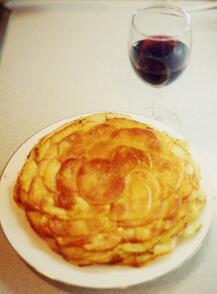Pommes Anna
A classic French potato dish
Pommes Anna[edit | edit source]
Pommes Anna is a classic French dish of sliced, layered potatoes cooked in a very large amount of butter. It is a simple preparation, but requires precision and care to achieve the desired texture and flavor.
Preparation[edit | edit source]
The dish is traditionally made using only four ingredients: potatoes, butter, salt, and pepper. The potatoes are peeled and sliced very thinly, typically using a mandoline. The slices are then layered in a circular pattern in a pan, with each layer brushed generously with melted butter and seasoned with salt and pepper.
The pan is then placed on the stove to start the cooking process, allowing the bottom layer to become golden and crisp. The dish is then transferred to an oven to finish cooking, ensuring that the interior layers are tender and the top is also crisped. Once cooked, the dish is inverted onto a plate so that the crisp bottom becomes the top.
History[edit | edit source]
Pommes Anna is said to have been created during the reign of Napoleon III by the chef Adolphe Dugléré at the Café Anglais in Paris. The dish was named after a woman, though the exact identity of "Anna" is not definitively known. It is a quintessential example of French culinary technique, showcasing the use of simple ingredients to create a dish with complex textures and flavors.
Serving[edit | edit source]
Pommes Anna is typically served as a side dish, often accompanying roasted meats or poultry. It can also be served as a vegetarian main course, given its rich and satisfying nature.
Variations[edit | edit source]
While the traditional recipe is quite strict, variations exist that incorporate additional ingredients such as garlic, herbs, or cheese. These variations can add complexity to the flavor profile, though purists may argue that they detract from the simplicity of the original dish.
Related pages[edit | edit source]
Search WikiMD
Ad.Tired of being Overweight? Try W8MD's physician weight loss program.
Semaglutide (Ozempic / Wegovy and Tirzepatide (Mounjaro / Zepbound) available.
Advertise on WikiMD
|
WikiMD's Wellness Encyclopedia |
| Let Food Be Thy Medicine Medicine Thy Food - Hippocrates |
Translate this page: - East Asian
中文,
日本,
한국어,
South Asian
हिन्दी,
தமிழ்,
తెలుగు,
Urdu,
ಕನ್ನಡ,
Southeast Asian
Indonesian,
Vietnamese,
Thai,
မြန်မာဘာသာ,
বাংলা
European
español,
Deutsch,
français,
Greek,
português do Brasil,
polski,
română,
русский,
Nederlands,
norsk,
svenska,
suomi,
Italian
Middle Eastern & African
عربى,
Turkish,
Persian,
Hebrew,
Afrikaans,
isiZulu,
Kiswahili,
Other
Bulgarian,
Hungarian,
Czech,
Swedish,
മലയാളം,
मराठी,
ਪੰਜਾਬੀ,
ગુજરાતી,
Portuguese,
Ukrainian
Medical Disclaimer: WikiMD is not a substitute for professional medical advice. The information on WikiMD is provided as an information resource only, may be incorrect, outdated or misleading, and is not to be used or relied on for any diagnostic or treatment purposes. Please consult your health care provider before making any healthcare decisions or for guidance about a specific medical condition. WikiMD expressly disclaims responsibility, and shall have no liability, for any damages, loss, injury, or liability whatsoever suffered as a result of your reliance on the information contained in this site. By visiting this site you agree to the foregoing terms and conditions, which may from time to time be changed or supplemented by WikiMD. If you do not agree to the foregoing terms and conditions, you should not enter or use this site. See full disclaimer.
Credits:Most images are courtesy of Wikimedia commons, and templates, categories Wikipedia, licensed under CC BY SA or similar.
Contributors: Prab R. Tumpati, MD

